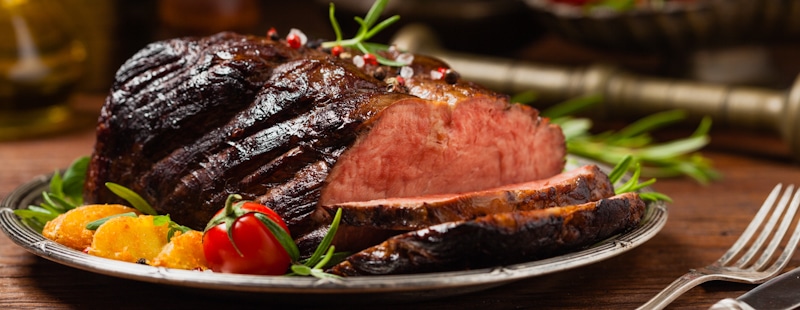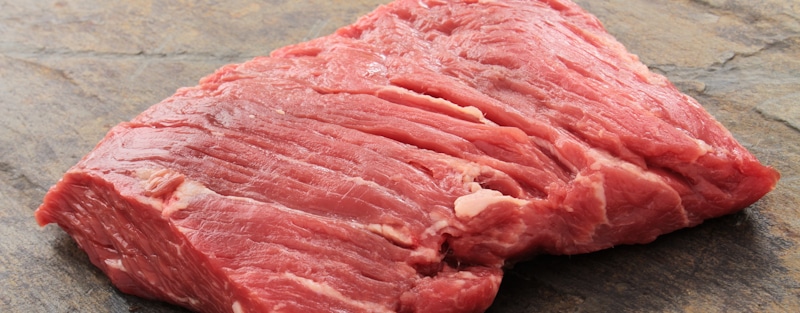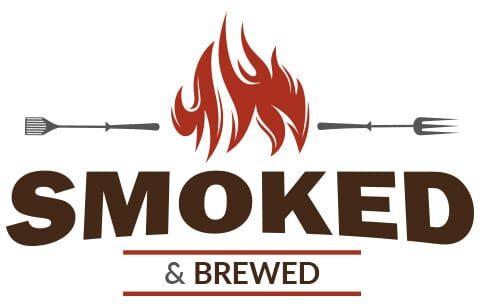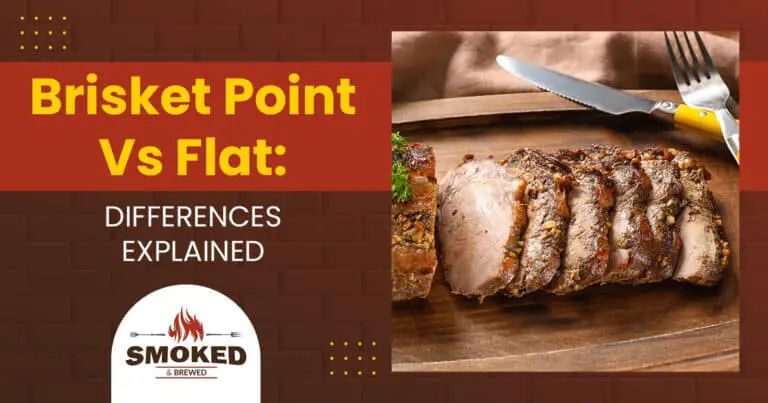Brisket is a large cut of beef obtained from the front portion (or lower breasts) of the cow. You can identify a good brisket when you see visi.’e and beautiful marbling on it. The portion of the meat is chewy and a tough cut that needs more time to prepare than other tender cuts of meat. But when you know the right technique, briskets can turn into the most flavorful and satisfying BBQ delight that you have prepared for your guests.
Brisket can be divided into two parts – Flat and Point Brisket. Flat brisket is leaner and chewier. Point brisket has a jagged triangular appearance and has better marbling, dense connective tissue, and an intense umami flavor than flat brisket. Both point and the flat brisket should be sliced against the grain, but with a slightly different approach.
Briskets are best cooked low and slow in a smoker or with the traditional braising method. Some of the most popular brisket dishes are pastrami, Texas-style BBQ brisket, and corned beef. But do you find it difficult to cut and process a brisket? Do the two types of brisket muscles require different cooking approaches? Continue reading and find out the difference between point cut and flat cut brisket.

Point Cut Vs Flat Cut Brisket
Beef brisket is made of connective tissue, collagen, and a layer of fat called the fat cap. Since brisket is obtained from the breast section of the cow which sees a lot of muscle movement, the meat derived from this area is tougher than other cuts of meat. As such, one can obtain two briskets per animal, that is, one on each side of the foreleg. Most butchers prefer smoking a whole brisket (or an untrimmed one). But, as the brisket is so large it may be cut into halves. Thus, a brisket is made of two types of muscles – the point and the flat. The differences are explained below.
What Is a Point Cut Brisket?
A point brisket or the ‘deckle’ is a fattier cut of brisket with a jagged triangular appearance. It is small, thick, and has dense connective tissue. This part also has more marbling (which means more fat) and tender muscles with an irregular grain.
The point cut is often relished as burnt ends and has a beautiful texture and flavor. If you are using a point for shredding, then always look for the fattiest cut of meat. Point brisket is often the perfect choice for hamburgers or BBQ beef sandwiches.
What Is a Flat Cut Brisket?
The flat brisket (often called ‘the first cut’) is leaner and a tougher cut of meat than the point. It has a thick fat layer on the top side known as the ‘fat cap’. The fat cap is responsible for rendering more flavor during the process of cooking.
Once cooked, the flat can be cut into uniform and long rectangular-shaped sections. The flat is often preferred if you want to cut the brisket into slices or want to prepare recipes such as corned beef sandwiches.
Here are some of the distinguishing feature that separates the point from the flat:
| Point Brisket | Flat Brisket | |
| Fat Content | A high percentage of fat marbling and connective tissue. | A low percentage of fat/ the meat is leaner than point brisket. |
| Flavor | Intense, umami/ beefy flavor | Less intense flavors. |
| Slicing | Against the grain. The slices are about ⅜ times thicker than the flat. | Against the grain. |
| Cooking | Easier to cook. | Due to the high amount of connective tissue, it is harder to cook. |
| Size | Non-uniform shape with thicker and thinner ends. | Larger and Uniform. |
| Best for | Shredding | Slicing, and recipes that require lean cuts. |
How To Cut Raw Brisket Point vs. Flat
You can separate the two portions of the brisket before or after low and slow cooking. Separating them before will produce faster cookouts.
Finding The Grain
Grain can be best explained as ‘strands of muscles that run through the meat.’ It is a series of lines that runs through when you cut the meat. The tenderness of the meat will depend on whether you cut the piece of the meat perpendicular or parallel to the grain. To find the grain, place the brisket flat on a cutting board and examine it closely.
Cutting Raw Brisket
If you have the whole brisket, the grains will run in different directions for the point and flat briskets. For the best results, use a brisket flat that is about 5-6 pounds in weight. The meat should not be stiff, which means it should have some bend. Once sourced, here’s how to cut a brisket.
- Lay the whole brisket on a clean surface with the fat side down.
- Use a sharp boning knife and reduce the fat cap to less than ¼ inches (some may even leave about ⅛ to 1 inch) by using small and gentle strokes against the grain. Continue separating the two muscles until you reach the thinnest portion or the nose/ point of the brisket.
Discard any extra fatty portions. Trimming allows for more seasoning and adding flavors to the meat. You may want to leave some fat if you are using the smoking method.
- Flip the slab and remove any excess fat and silver skin.
- Once you have ripped apart the two portions and reached the thinnest portion of the flat, the two halves of the brisket get fully separated.
Have a look at this video to learn how to separate a point from a flat brisket.
Brisket Flat vs. Point Which Takes Longer
Since the point is a fattier cut, it cooks faster than the brisket flat.
The general thumb rule is that you would require smoking a brisket flat for about 1 ½ hour per pound of meat (which also includes the resting phase). On the other hand, the point takes about 30 to 60 minutes to cook per pound at the same temperature. Since all pieces are different with different fat content, it is better to monitor the internal temperature than rely on the recommended time required for cooking.
How Long To Oven Roast Flat vs. Point Brisket?
Both point and flat cuts produce great results when cooked low and slow in a smoker. Just remember that the higher the fat percentage, the less would be the net amount of meat obtained.
Oven roast flat brisket is best done at 250 degrees Fahrenheit for about 5 hours or until the internal temperature reaches 165 to 170 degrees Fahrenheit. Once this temperature is reached, pull the brisket out of the oven, add some basting liquid and tightly wrap it in butcher paper. This is done to avoid stalling. Next, place the wrapped brisket back into the oven and continue smoking until the internal temperature reads 200 to 210 degrees Fahrenheit. Oakwood or fruitwoods like Applewood and Cherrywood are the best for smoking briskets.
Once the brisket is done, let it rest for about 30 to 60 minutes before you slice, chop, or process it further. The resting period completes the cooking process, redistributes flavorful juices, and restores the tenderness of the meat.
How To Cut Brisket Point vs. Flat
Slicing the point and the flat separately helps you segregate lean and fatty portions of the meat.
For slicing or cutting the cooked brisket, you would need a long, sharp, and serrated knife that can cut through tough portions of the meat.

Brisket Point
After the resting period is over, start with the end that is opposite to the nose or the point
and slice the brisket perpendicular to the grain (about ½ inch or about pencil-width thick rectangular flat pieces). Start with thicker slices and end with thinner ones.
Brisket Flat
Point slices are usually thicker than flat. Cut the slices across the muscle and gradually taper the slices as you reach the end. If the meat tends to fall apart, you can try a slightly thicker cut. Always use short and gentle strokes and work your way from the top to the bottom. You may also trim away extra fat during the process.
Once you start slicing cooked brisket, it will start oxidizing immediately. Therefore, it is best to hold off on slicing the delicious BBQued recipe until you are ready to serve.
Scot has loved smoking food in his free time for the last few years. Each major holiday or off-weekend, Scot spends days testing and prepping new recipes for perfection.

